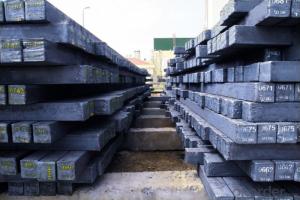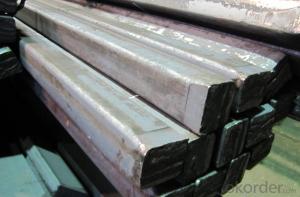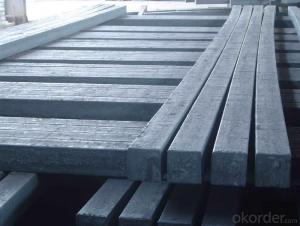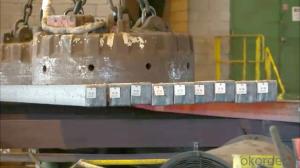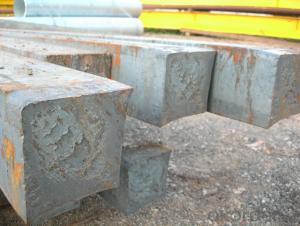Hot Rolled Steel Billet 3SP Standard 170mm
- Loading Port:
- Shanghai
- Payment Terms:
- TT OR LC
- Min Order Qty:
- 100 m.t.
- Supply Capability:
- 10000 m.t./month
OKorder Service Pledge
OKorder Financial Service
You Might Also Like
Structure of Hot Rolled Steel Billet 3SP Standard 170mm

Description of Hot Rolled Steel Billet 3SP Standard 170mm
Prepainted Rolled steel Coil is a kind of coated steel coil/sheet. With the cold rolled steel of different strength and thickness as substrate, it is produced through applying Al-Zn coat on both faces by hot dip process. In its coating, Al accounts for about 55%, Si 1.6%, while the remaining is Zn. Aluminum zinc coils enjoys both the physical protective feature and durability of Al and the electrochemical protective property of Zn. And its surface has bright silver color and regular embossed-like figure, which are highly decorative. RAL Scale Z35 Prepainted Rolled Steel Coil for Construction Roofing

Main Feature of Hot Rolled Steel Billet 3SP Standard 170mm
1.Corrosion resistance: It mainly depends on the zinc protection. When the zinc being worn,
2. Heat resistance: steel sheet has excellent heat resistance, can withstand high temperatures over 300 centigrade, and is similar with aluminized steel high temperature oxidation resistance. It often used in chimney pipes, ovens, fluorescent lighting device and the device cover.
3. Heat reflective: Galvanized steel plate heat-reflective high rate is twice as galvanized steel, often used to make insulation materials. RAL Scale Z35 Prepainted Rolled Steel Coil for Construction Roofing
Applications of Hot Rolled Steel Billet 3SP Standard 170mm
1. Construction and building: roofing; ventilating duct; handrail; partition panel;etc.
2. Electric appliance: refrigerator; washing machine; refrigerator; DVD;etc.
3.Transportation: oil tank; gas tank;road sign; etc.
4.Agriculture constructions :barn; etc.RAL Scale Z35 Prepainted Rolled Steel Coil for Construction Roofing
5.Others:vending machine; game machine; auto parts spare parts etc.
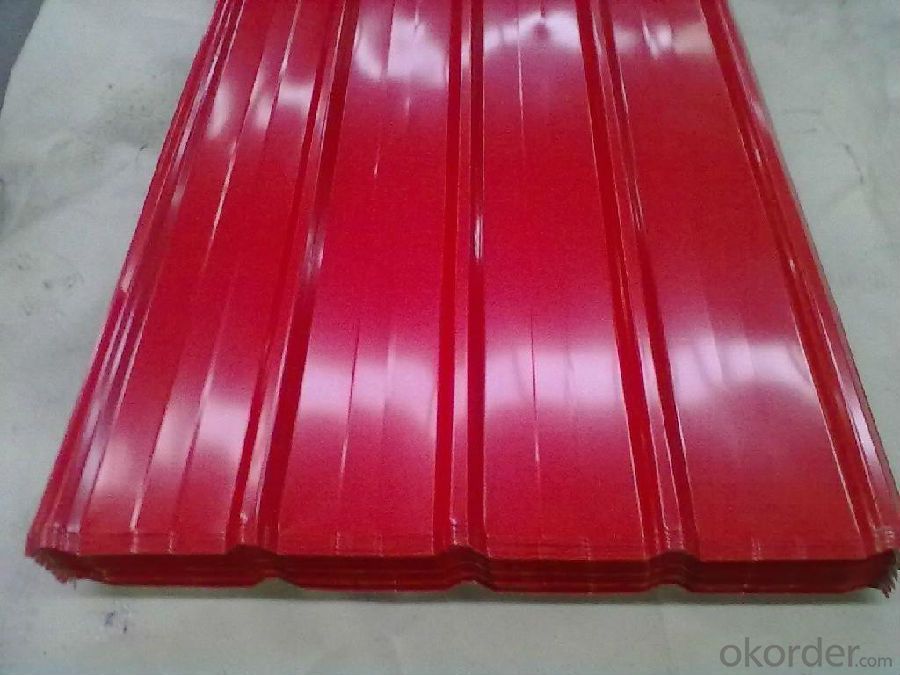
Specifications of Hot Rolled Steel Billet 3SP Standard 170mm
Product | Hot Rolled Steel Billet 3SP Standard 170mm |
Material Grade | SGCC / SGCH / DX51D+AZ, etc |
Thickness | 0.5-3.0mm |
Width | 700-1500mm |
Tolerance | Thickness: +/-0.02mm , Width:+/-2mm |
Zinc-coating | AZ30-150g/m2 |
Technique | Raw material: Hot rolled steel coil --> Cold rolled_>hot dipped galvalume |
Surface | Dried, Chromated, Unoiled,RAL Scale Z35 Prepainted Rolled Steel Coil for Construction Roofing |
Spangle | Regular spangle , small spangle, zero spangle |
ID | 508MM 610MM |
Coil weight | 25MT max |
Export package | Cardboard inner sleeves, Waterproof paper, galvanized steel covered and steel strip packed |
FAQ of Hot Rolled Steel Billet 3SP Standard 170mm
We have organized several common questions for our clients,may help you sincerely:
1. What is the minimum order quantity ?
Our MOQ is 100 mt for each size each specification. Usually we can offer discount if can buy large QTY once. RAL Scale Z35 Prepainted Rolled Steel Coil for Construction Roofing
2. How long can we receive the product after ordering?
Our general delivery time is 30 days after confirmation, but so some special orders, we have offer special delivery time
3. How to guarantee the quality of the products?
We have established the international advanced quality management system ,every link from raw material to final product we have strict quality test;We resolutely put an end to unqualified products flowing into the market. At the same time, we will provide necessary follow-up service assurance.
4. What is the payment?
We accept T/T, L/C
- Q:How are steel billets used in the manufacturing of agricultural equipment?
- Steel billets are an integral component in the manufacturing process of agricultural equipment. These billets, which are essentially semi-finished steel products, serve as the raw material for producing various parts and components of agricultural machinery. One of the primary uses of steel billets in agricultural equipment manufacturing is for the construction of the frame or chassis of the equipment. The frame provides the structural integrity and support necessary to withstand the demanding conditions encountered in agricultural applications. Steel billets are often used due to their high strength, durability, and resistance to corrosion, which are crucial qualities required for withstanding the heavy loads, vibrations, and exposure to harsh environments that agricultural machinery often faces. Additionally, steel billets are used in the production of other important components such as axles, gears, shafts, and blades. These components are critical for the proper functioning and performance of agricultural equipment. Steel billets are preferred for these applications due to their machinability, allowing them to be easily shaped and formed into the desired specifications and dimensions required for each component. Furthermore, steel billets are also utilized in the manufacturing of attachments and implements that are commonly used in agricultural operations. For instance, plows, harrows, cultivators, and seeders, all rely on steel billets to provide strength, durability, and resistance to wear and tear. These attachments are often subjected to demanding conditions and need to withstand the forces encountered during field operations. Overall, steel billets play a crucial role in the manufacturing of agricultural equipment by providing the necessary strength, durability, and functionality required for these machines to perform effectively in the agricultural sector. The use of steel billets ensures that the agricultural equipment can withstand the harsh conditions of farming operations, resulting in increased productivity, efficiency, and longevity of the machinery.
- Q:How are steel billets used in the production of electrical appliances?
- Steel billets are used in the production of electrical appliances in several ways. Firstly, steel billets are often used as the raw material for manufacturing various components of electrical appliances. These billets can be shaped and molded into different forms such as sheets, plates, bars, or wires, depending on the specific needs of the appliance. For instance, steel billets can be rolled into thin sheets which are then used to form the outer casing or body of electrical appliances like refrigerators, washing machines, or air conditioners. These sheets provide durability, strength, and protection to the internal components of the appliance. Additionally, steel billets can be further processed to create bars or wires that are used in the production of electrical connections, circuit breakers, or switches. These components require high electrical conductivity, resistance to heat, and mechanical strength, which steel billets can provide. Furthermore, steel billets are also used to manufacture various motors and transformers that are integral to the functioning of electrical appliances. These billets are shaped and machined to create specific parts like rotor cores, stator cores, or laminated cores, which are essential for the efficient conversion of electrical energy. In summary, steel billets play a crucial role in the production of electrical appliances by providing the necessary raw material for creating components like casings, bars, wires, and cores. Their properties of strength, durability, electrical conductivity, and heat resistance make them an ideal choice for ensuring the reliability and functionality of electrical appliances.
- Q:How are steel billets used in the manufacturing of castings?
- Steel billets are used in the manufacturing of castings as a raw material that is heated and melted to create the molten metal for casting. The billets are then poured into molds to form the desired shape, which is later solidified and cooled to obtain the final casting product.
- Q:How are steel billets used in the manufacturing of construction scaffolding?
- Steel billets are used in the manufacturing of construction scaffolding as they serve as the primary raw material. These billets are first heated and then passed through a series of processes such as rolling, cutting, and shaping to form the necessary components of scaffolding, including tubes, frames, and joints. The high strength and durability of steel make it an ideal choice for scaffolding, ensuring the safety and stability required for construction workers.
- Q:What is the role of steel billets in the construction industry?
- Steel billets play a crucial role in the construction industry as they serve as the raw material for manufacturing various steel products. These solid, semi-finished forms of steel are typically used in the production of beams, bars, rods, and other structural components. By providing strength, durability, and flexibility to structures, steel billets contribute significantly to the overall integrity and safety of buildings, bridges, and other infrastructure projects.
- Q:How are steel billets used in the manufacturing of machinery and equipment?
- Steel billets are an essential component in the manufacturing of machinery and equipment. These billets, which are semi-finished steel products, serve as the raw material that is further processed to create various components used in machinery. To begin with, steel billets are heated to a high temperature and then rolled or forged into different shapes, such as bars, rods, or tubes. These shapes are then machined and fabricated into specific parts and components required in machinery and equipment. For instance, steel billets can be transformed into gears, shafts, axles, pistons, and other crucial components that are used in engines, turbines, and other types of machinery. The use of steel billets in manufacturing machinery and equipment offers several advantages. Firstly, steel is known for its exceptional strength and durability, making it a suitable material for heavy-duty applications. Steel billets provide the necessary strength and rigidity required to withstand the demanding conditions and stresses that machinery and equipment often experience during operation. Secondly, steel billets can be easily molded and shaped according to specific design requirements. This flexibility allows manufacturers to produce complex and intricate components that are critical for the efficient functioning of machinery. The ability to customize the shape and size of steel billets enables the production of parts that fit seamlessly within the machinery, ensuring optimum performance and functionality. Moreover, steel billets possess excellent mechanical properties, including high tensile strength, hardness, and resistance to wear and corrosion. These properties not only enhance the longevity of machinery but also contribute to its overall performance and reliability. Steel billets are capable of withstanding harsh operating conditions and can endure significant loads and forces without deformation or failure. In conclusion, steel billets play a pivotal role in the manufacturing of machinery and equipment. Through various processing techniques, these billets are transformed into different components that are vital for the operation of machinery. The strength, flexibility, and durability offered by steel billets make them an ideal choice for the production of machinery that can withstand the demanding requirements of various industries.
- Q:What are the common shipping methods for steel billets?
- The common shipping methods for steel billets include sea transportation, rail transportation, and truck transportation.
- Q:How do steel billets contribute to the manufacturing of automotive components?
- Steel billets are the starting point for the manufacturing of automotive components as they are heated and shaped into various forms such as rods, bars, and sheets. These billets are strong, durable, and can be easily molded into the desired shape, making them ideal for producing structural automotive parts like engine blocks, chassis, and suspension components. Additionally, steel billets provide the necessary strength and stability required to withstand the harsh conditions and loads experienced by automotive components, ensuring the overall safety and reliability of vehicles.
- Q:How are steel billets tested for strength and durability?
- To ensure the strength and durability of steel billets, rigorous examinations and tests are conducted. The objective is to verify that the billets possess the necessary properties to withstand their intended application and perform optimally in diverse conditions. The tensile strength test is a key evaluation performed on steel billets. This involves gradually increasing the axial load on the billet until it reaches its breaking point. By measuring the applied force and resulting deformation, the ultimate tensile strength can be determined. This test assesses the steel's ability to resist external forces and provides vital information about its structural integrity. Another crucial assessment is the hardness test, which measures the steel billet's resistance to indentation or scratching. Various methods, such as the Brinell, Rockwell, or Vickers hardness tests, can be used to determine the hardness value. This information helps evaluate the billet's resistance to wear, deformation, and potential damage. Heat treatment is also vital in testing the strength and durability of steel billets. This process involves controlled heating and cooling cycles to modify the billets' microstructure, resulting in improved mechanical properties. By carefully monitoring temperature, time, and cooling rate during heat treatment, desired properties like increased strength and toughness can be achieved. Furthermore, non-destructive testing techniques, like ultrasonic testing, magnetic particle inspection, and radiographic examination, are employed to assess internal quality and identify any potential defects or flaws in the billets. These methods provide valuable information about the billet's structural soundness, ensuring it meets required standards and specifications. Additionally, chemical composition analysis is conducted to verify the elemental composition of the steel billets. This analysis ensures that the alloying elements are within specified limits, as they significantly affect mechanical properties. Any deviation from the required composition could compromise strength and durability. In conclusion, steel billets undergo a comprehensive series of tests and evaluations to ensure strength and durability. These include tensile strength testing, hardness testing, heat treatment, non-destructive testing, and chemical composition analysis. By subjecting the billets to these assessments, manufacturers can guarantee the quality of their steel products, ensuring they meet the demanding requirements of various applications.
- Q:How are steel billets rolled into shape?
- Steel billets are rolled into shape through a process called hot rolling. This process involves heating the steel billet to high temperatures, typically above 1,000 degrees Celsius, to make it malleable and easier to shape. The heated billet is then passed through a series of rolling mills, which consist of a pair of cylindrical rollers that rotate in opposite directions. As the billet passes through the rollers, it is gradually compressed and elongated, resulting in a desired shape and size. The rollers apply high pressure on the billet, effectively reducing its thickness and increasing its length. This continuous rolling process allows for precise control over the shape and dimensions of the steel product. To ensure smooth rolling and prevent the billet from sticking to the rollers, lubricants are often applied. These lubricants also help in dissipating the heat generated during the rolling process. Depending on the desired final product, the steel billet may undergo multiple passes through the rolling mills to achieve the desired shape and dimensions. After the initial rough rolling, the steel may be further shaped and refined through additional rolling stages. Once the desired shape is achieved, the steel is then allowed to cool and solidify. This cooling process is crucial to ensure the final product has the desired mechanical properties and structural integrity. Overall, the hot rolling process of steel billets is a crucial step in the production of various steel products. It allows for the efficient shaping and forming of the billets into different shapes, sizes, and profiles, meeting the specific requirements of different industries such as construction, automotive, and manufacturing.
1. Manufacturer Overview |
|
|---|---|
| Location | |
| Year Established | |
| Annual Output Value | |
| Main Markets | |
| Company Certifications | |
2. Manufacturer Certificates |
|
|---|---|
| a) Certification Name | |
| Range | |
| Reference | |
| Validity Period | |
3. Manufacturer Capability |
|
|---|---|
| a)Trade Capacity | |
| Nearest Port | |
| Export Percentage | |
| No.of Employees in Trade Department | |
| Language Spoken: | |
| b)Factory Information | |
| Factory Size: | |
| No. of Production Lines | |
| Contract Manufacturing | |
| Product Price Range | |
Send your message to us
Hot Rolled Steel Billet 3SP Standard 170mm
- Loading Port:
- Shanghai
- Payment Terms:
- TT OR LC
- Min Order Qty:
- 100 m.t.
- Supply Capability:
- 10000 m.t./month
OKorder Service Pledge
OKorder Financial Service
Similar products
New products
Hot products
Hot Searches
Related keywords

